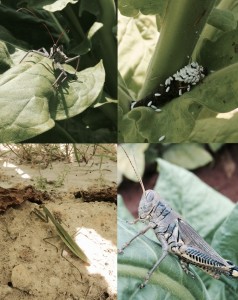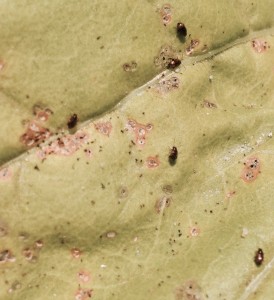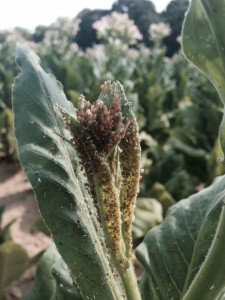Tobacco Insect Scouting Report, August 7 2015
go.ncsu.edu/readext?368209
en Español / em Português
El inglés es el idioma de control de esta página. En la medida en que haya algún conflicto entre la traducción al inglés y la traducción, el inglés prevalece.
Al hacer clic en el enlace de traducción se activa un servicio de traducción gratuito para convertir la página al español. Al igual que con cualquier traducción por Internet, la conversión no es sensible al contexto y puede que no traduzca el texto en su significado original. NC State Extension no garantiza la exactitud del texto traducido. Por favor, tenga en cuenta que algunas aplicaciones y/o servicios pueden no funcionar como se espera cuando se traducen.
Português
Inglês é o idioma de controle desta página. Na medida que haja algum conflito entre o texto original em Inglês e a tradução, o Inglês prevalece.
Ao clicar no link de tradução, um serviço gratuito de tradução será ativado para converter a página para o Português. Como em qualquer tradução pela internet, a conversão não é sensivel ao contexto e pode não ocorrer a tradução para o significado orginal. O serviço de Extensão da Carolina do Norte (NC State Extension) não garante a exatidão do texto traduzido. Por favor, observe que algumas funções ou serviços podem não funcionar como esperado após a tradução.
English
English is the controlling language of this page. To the extent there is any conflict between the English text and the translation, English controls.
Clicking on the translation link activates a free translation service to convert the page to Spanish. As with any Internet translation, the conversion is not context-sensitive and may not translate the text to its original meaning. NC State Extension does not guarantee the accuracy of the translated text. Please note that some applications and/or services may not function as expected when translated.
Collapse ▲We are seeing a slight increase in flea beetles at some sites, but population sizes remain well below threshold levels. The image above shows flea beetle and holes caused by their feeding which have a lace-like appearance. For large plants post-topping, the flea beetle threshold increases to 60 beetles per plant. Although it may be difficult to observe that many beetles per plant, while scouting this week we did see as many as 30 beetles on a single plant. Many sites are harvesting now, so the lower leaves are being removed which makes it easier to inspect plants.
One of our Piedmont sites will be treating this week for hornworms as we were at 26% infested plants in both the IPM and the standard field at that location. We are still below threshold at all of our other sites.
Although aphid pressure remains high at the Oxford research station, we have yet to see any aphid infestations at our on-farm sites. The photo above shows how aphids can quickly result in a heavy infestation under favorable conditions. The photo below is a few other insects we saw this week while scouting. Higher predator and parasitoid species diversity may help to control pests due to differences in feeding behavior. Using better target-specific insecticides to only control the pests that are present in the field will help to promote this diversity. Another project in our lab is investigating this diversity in organic tobacco production as a supplement to chemical control.

Wheelbug, predator. Stiltbugs feeding on parasitized hornworm. Praying Mantis, predator. Grasshopper, minor pest. (Clockwise from top left) Photos: Jeremy Slone
Eastern 1
Scouting Report, Eastern 1 – Grower Standard Field
| Insect observation | No. aphid infested plants | Flea beetles per plant | Percent tobacco budworm infested plants | Hornworms per plant | Percent cutworm damaged plants | Other insects |
| Treatment needed? | 0 – No treatment | 1.3 flea beetles/plant– No treatment | 0% infested – No treatment | 0 – No treatment | 0 – No treatment |
Scouting Report, Eastern 1 – IPM Field
| Insect observation | No. aphid infested plants | Flea beetles per plant | Percent tobacco budworm infested plants | Hornworms per plant | Percent cutworm damaged plants | Other insects |
| Treatment needed? | 0 – No treatment | 1.61 flea beetles/plant– No treatment | 0% infested – No treatment | 0% – No treatment | 0 – No treatment |
Eastern 2
Scouting Report, Eastern 2 – Grower Standard Field
| Insect observation | No. aphid infested plants | Flea beetles per plant | Percent tobacco budworm infested plants | Hornworms per plant | Percent cutworm damaged plants | Other insects |
| Treatment needed? | 0 – No treatment | .11 flea beetles/plant– No treatment | 1% infested – No treatment | 0 – No treatment | 0 – No treatment |
Scouting Report, Eastern 2 – IPM Field
| Insect observation | No. aphid infested plants | Flea beetles per plant | Percent tobacco budworm infested plants | Hornworms per plant | Percent cutworm damaged plants | Other insects |
| Treatment needed? | 0 – No treatment | 0.99 flea beetles/plant– No treatment | 1% infested – No treatment | 1% – No treatment | 0 – No treatment |
Eastern 3
Scouting Report, Eastern 3 – Grower Standard Field
| Insect observation | No. aphid infested plants | Flea beetles per plant | Percent tobacco budworm infested plants | Hornworms per plant | Percent cutworm damaged plants | Other insects |
| Treatment needed? | 0 – No treatment | 2.28 flea beetles/plant– No treatment | 0% infested – No treatment | 0% – No treatment | 0 – No treatment |
Scouting Report, Eastern 3 – IPM Field
| Insect observation | No. aphid infested plants | Flea beetles per plant | Percent tobacco budworm infested plants | Hornworms per plant | Percent cutworm damaged plants | Other insects |
| Treatment needed? | 0 – No treatment | 0.6 flea beetles/plant– No treatment | 0% infested – No treatment | 2% – No treatment | 0 – No treatment |
_________________________________________________________________
Piedmont 1
Scouting Report, Piedmont 1 – Grower Standard Field
| Insect observation | No. aphid infested plants | Flea beetles per plant | Percent tobacco budworm infested plants | Hornworms per plant | Percent cutworm damaged plants | Other insects |
| Treatment needed? | 0 – No treatment | 1.78 flea beetles/plant– No treatment | 0% infested – No treatment | 0 – No treatment | 0 – No treatment |
Scouting Report, Piedmont 1 – IPM Field
| Insect observation | No. aphid infested plants | Flea beetles per plant | Percent tobacco budworm infested plants | Hornworms per plant | Percent cutworm damaged plants | Other insects |
| Treatment needed? | 0 – No treatment | 2.53 flea beetles/plant– No treatment | 0% infested – No treatment | 0 – No treatment | 0 – No treatment |
Piedmont 2
Scouting Report, Piedmont 2 – Grower Standard Field
| Insect observation | No. aphid infested plants | Flea beetles per plant | Percent tobacco budworm infested plants | Hornworms per plant | Percent cutworm damaged plants | Other insects |
| Treatment needed? | 0 – No treatment | 0.46 flea beetles/plant– No treatment | 0% infested – No treatment | 26% – over threshold | 0 – No treatment |
Scouting Report, Piedmont 2 – IPM Field
| Insect observation | No. aphid infested plants | Flea beetles per plant | Percent tobacco budworm infested plants | Hornworms per plant | Percent cutworm damaged plants | Other insects |
| Treatment needed? | 0 – No treatment | 0.42 flea beetles/plant– No treatment | 2% infested – No treatment | 26% – Req treatment | 0 – No treatment |
Piedmont 3
Scouting Report, Piedmont 3– Grower Standard Field
| Insect observation | No. aphid infested plants | Flea beetles per plant | Percent tobacco budworm infested plants | Hornworms per plant | Percent cutworm damaged plants | Other insects |
| Treatment needed? | 0 – No treatment | 0.18 flea beetles/plant– No treatment | 0% infested – No treatment | 2% – No treatment | 0 – No treatment |
Scouting Report, Piedmont 3 – IPM Field
| Insect observation | No. aphid infested plants | Flea beetles per plant | Percent tobacco budworm infested plants | Hornworms per plant | Percent cutworm damaged plants | Other insects |
| Treatment needed? | 0 – No treatment | 0.07 flea beetles/plant– No treatment | 0% infested – No treatment | 6% – No treatment | 0 – No treatment |
More information
Tobacco insect scouting methods – Tobacco Growers Information Portal




